Beara of glad tidings: south-west Ireland’s other great peninsula
Beara of glad tidings: south-west Ireland’s other great peninsula
The Beara peninsula is less popular than nearby honeypots such as the Ring of Kerry – and all the better for it, says Philip Watson, who discovers rugged scenery, stone circles and great little bars
The vast majority of visitors to south-west Ireland head out to fashionable foodie West Cork, loop round the famous Ring of Kerry, or strike out for Dingle and its resident dolphin. They bypass, however, the best bit in between: the staggeringly beautiful Beara peninsula, Ireland’s foremost hidden travel gem.
“The peninsula’s remoteness has been more a blessing than a curse,” says Marc O’Sullivan Vallig, artistic director of the summer Beara arts festival. “Not only has Beara been fortunate enough to miss out on the kind of coachload tourism that has become synonymous with the Ring of Kerry, but there’s also nowhere else quite like it on the entire Wild Atlantic Way.”
Beara is beyond; it’s different. A tapering 30 mile-long forefinger of land that pokes powerfully out into the ocean, it feels far more rugged, ancient and untamed than its next-door neighbours. The formidable Caha and Slieve Miskish mountain ranges run along Beara’s humpy backbone, the sweeping coastline is endlessly sculpted and indented, and the deserted beaches are mostly shingle and stone. There’s often an enduring sense of isolation and emptiness out here; you feel on the edge of something on Beara – a county (the peninsula is split between Cork and Kerry), a country, a continent, even a culture.
Because of this, Beara has always drawn people attracted to the fringes – hippies, artists, poets and eco-pioneers – and a certain kind of adventurous visitor, interested in walking, cycling, history, and the arts.
My most recent visit started in Glengarriff, a village warmed by the waters of the Gulf Stream, self-proclaimed as one of the sunniest and most sheltered spots in Ireland, and unofficial gateway to the Beara peninsula. Located at the head of Bantry Bay, and surrounded by wooded hillsides and glacial valleys, Glengarriff offers riverside walks and panoramic lookouts among the mosses, ferns and oak forests in its nearby nature reserve.
We stayed at Casey’s Hotel (doubles from €78 B&B), a comfortable, family-run, three-star sort of place, and ate plates of fine local cured meats and farmhouse cheeses (including Milleens, a soft full-flavoured cheese produced on Beara) at Manning’s Emporium, a casual cafe-deli a few miles down the road in Ballylickey.
From Glengarriff, walkers head out on the scenic, circular and clearly waymarked 137-mile Beara Way, a route that hugs hillsides and coastlines and more than rivals the more well-trodden trails such as the Wicklow Way. Cyclists can enjoy an 85-mile version that is no less challenging or rewarding.
But for this trip we were driving, following an elongated figure of eight that has the major benefit of taking you over one of Ireland’s most spectacular mountain roads – twice. The Healy Pass is best approached from Adrigole on Beara’s southern coast, near craggy-faced Hungry Hill, and climbs, loops and switches back, past barren hills streaked with rivers and streams, to a 330-metre summit. From there, looking north, you have one of Ireland’s great vistas: a view down past romantic Glanmore Lake, across choppy Kenmare Bay to the peaks and stacks of Macgillycuddy’s Reeks, the country’s highest mountain range.
The pass swoops down to the tiny hamlet of Lauragh – we lunched at Pedals & Boots, a fine local cafe that offers homemade treats, cycle hire, showers and a post office – and we came to a junction that perfectly illustrated the recurring Beara dilemma: whichever way we turned, we would come to something surprising and extraordinary.
We took the coast road to Derreen, an informal yet skilfully maintained woodland estate (with a classy new cafe) that hosts one of the most enchanting gardens in Ireland. Rich in azaleas, rhododendrons and avenues of giant New Zealand tree ferns, it was like strolling into a scene from The Hobbit. Further on, in a stunning location right by a small working pier at Kilmackillogue, was Teddy O’Sullivan’s, a proudly unpretentious local pub (and B&B, €30pp, +353 64 66 83104) with a timeless front bar serving perfect pints of Guinness and bowls of mussels from the nearby bay.
A mile or so before we arrived at Ardgroom, further west along Beara’s northern edge, we found another spot with a majestic view: the Ardgroom stone circle. Beara is dotted with an exceptional concentration of more than 600 archaeological sites – from standing stones to megalithic tombs and ring forts – and Ardgroom’s 3,000-year-old ceremonial stone circle is one of the country’s finest, its nine surviving pillars, plus one outside of the circle, still standing tall.
In Beara’s “capital”, Castletownbere, we checked into the recently refurbished Beara Coast Hotel (doubles from €100 B&B) – a four-star hotel on a headland across the harbour that is considerably smarter and more comfortable than its utilitarian exterior might suggest.
“What I like about Castletownbere is that it’s a working town – it’s the largest white fish port in Ireland – and not quite so reliant on tourism,” said Sarah Walker, whose eponymous waterside art gallery is housed in an impressively converted fishing warehouse.
MacCarthy’s Bar is the venue for most of author Pete McCarthy’s spontaneous “all-night hooley” of drink, talk, song, dance and more drink, so vividly described in his book McCarthy’s Bar. It’s pretty much unchanged since Pete was here in 1999: part pub, part grocery shop, and full centre of social life in the town. It was voted Irish Pub of the Year 2016. There’s a sign above the door. Not that anybody takes much notice.
From Castletownbere, over the next couple of days, we explored Beara’s more bleak and distant western tip. We took “the only cable car that traverses open seawater in all of Europe”, the wholly unexpected Dursey Island cable car at the far end of the peninsula, which offers a thrilling 10-minute ride over an often turbulent sound of water. The eight-mile loop walk around the long, slender and largely uninhabited isle is a second great adventure. And then you can go no further.
The following evening we were in the handsome and popular tourist town of Kenmare, with its excellent (if expensive) restaurants, plentiful gift shops and five-star places to rest (we stayed at the stylish and serene Sheen Falls Lodge, doubles from €185 B&B), just outside the town.
Kenmare is at the head of the bay, just across from Beara “on the other side” – the Iveragh or Ring of Kerry peninsula. Yet it felt a million miles from places such as the Healy Pass, Kilmackillogue, Ardgroom and Dursey.
ONLY HERE FOR THE BEARA: FIVE MORE THINGS TO SEE
Picturesque village
From Ardgroom we took the longer, twisting and dipping “Ring of Beara” coast road to Eyeries, a 14-mile route, no wider than a single track in places, that provided striking seascapes and big watery skies. In the picturesque village of Eyeries, home to rows of brightly painted houses and two great pubs, we stopped at Rhonwen’s Eyeries Bistro, an informal family-run restaurant, with a fine collection of work by local artists, that is about the best place to eat right now on the peninsula.
Historical island
A 15-minute car ferry from Castletownbere slowly transports you to the remarkable remove of Bere Island, a once-strategic outpost at the entrance to Bantry Bay that is surprisingly rich in archaeological and historical sites. There are ring forts, standing stones, burial mounds and remnants of “British imperialism” – Martello towers, barracks and a fortification with two six-inch guns. Stay over at the simple yet welcoming Bere Island Lodge (doubles from €70 B&B).
Ruined castle
Two miles along the road west from Castletownbere, we scrambled around the ruins of Dunboy Castle, 16th-century stronghold of the rebellious O’Sullivan Beara clan, and peered through the high-wire fences surrounding the nearby 19th-century Puxley Mansion. An abiding symbol both of the burning of “big houses” by the IRA in the 1920s and the hubris of the Celtic Tiger, the 90% restored but never opened manor house was to be Ireland’s first six-star hotel.
Nature park
On Beara’s northern slopes, just nine miles or so before you come to Kenmare, lies the long, narrow glacial valley of Gleninchaquin. A working sheep farm now also run as a private nature park, the area has marked paths, hill walks and log footbridges that lead you past streams, cascades, rock pools, lakes and native oak forests to a spectacular 140 metre-high waterfall, which has views across the glens and woodlands to Kenmare Bay and the mountains of Macgillycuddy’s Reeks. The perfect place for a picnic.
Copper mine
Described as the most remote village in Ireland, in that it’s about as far as you can get from Dublin without falling off the edge, Allihies is a bleakly beautiful sort of a place, home to artists, outcasts and, in the 19th century, a community of copper miners, some of whom came from Cornwall. Their resilient lives and hard times are remembered at the well-run Allihies Copper Mine Museum, housed in a former Methodist church. Nearby is Ballydonegan beach, some of which is formed from crushed quartz washed down from the mines. When the many shafts were no longer viable, generations of miners migrated from Allihies to Butte, Montana, a state that calls itself “The Last Best Place”. It’s a phrase you could just as easily apply to Beara.
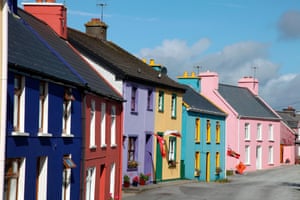
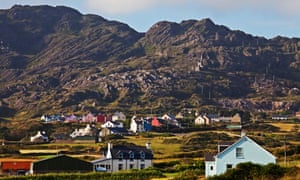
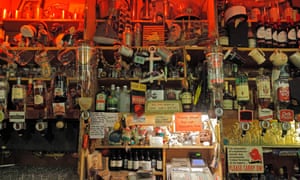
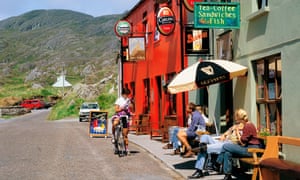

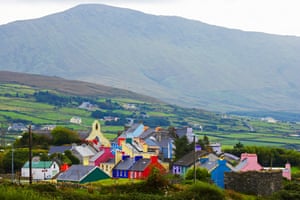
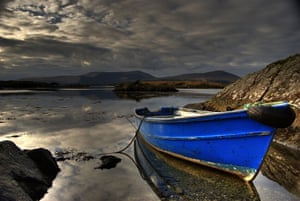





Nessun commento: